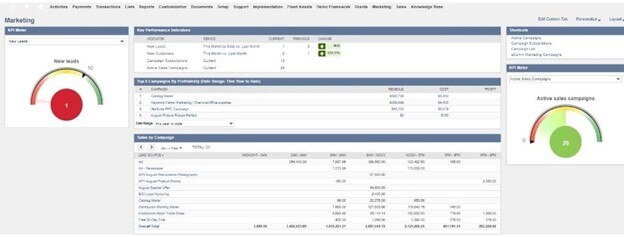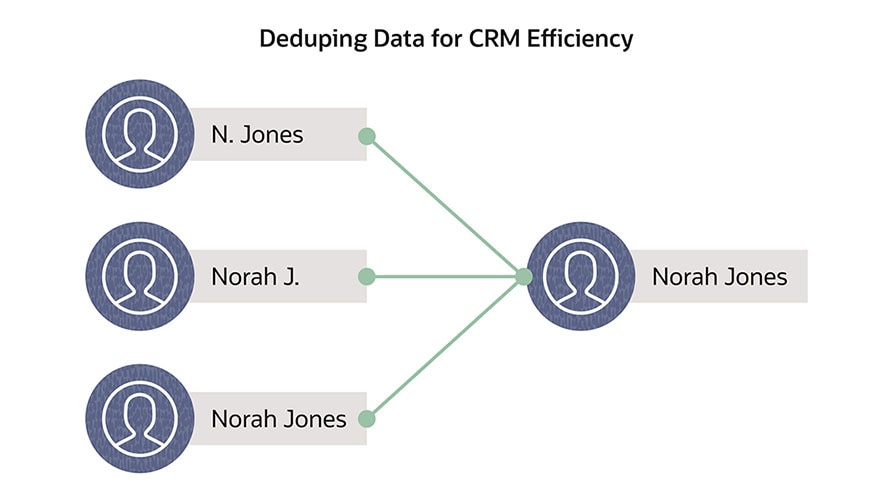A solid customer relationship management (CRM) strategy is crucial for any business that wants to thrive in competitive markets. CRM strategies help businesses increase revenue by enhancing customer relationships and grow profit by reducing the costs of acquiring, retaining and upselling customers. Though the specifics of a CRM strategy will differ by industry and the circumstances of a business, all CRM strategies are game plans for combining technology, people and processes in ways that improve the relationship between customers and the company’s sales, marketing and customer service teams.
In common usage, CRM refers to both a strategy and the type of software that helps deliver that strategy. The strategy guides a business’s CRM approach, while the software implements and — in many cases — enforces it. By implementing these strategies, businesses gain a better understanding of their customers that can lead to improved operations.
What Is a CRM Strategy?
A CRM strategy defines goals and practices that a company will use to manage and improve its interactions with customers via a CRM system. In other words, it’s a plan to build stronger relationships with existing customers and generate more leads among prospective customers. Effective CRM strategies enable sales, marketing and customer service teams to tailor their interactions with prospects and customers using data-driven insights on customer behaviours, needs and preferences. These tailored interactions, delivered consistently, create truly customer-centric journeys that catalyse customer loyalty and, ultimately, business growth.
CRM strategies spring from the overarching goals that a company has for its customer relationships. Examples of CRM strategy goals include increasing customer satisfaction, improving customer experience and streamlining the sales process. These goals establish the priorities for a CRM implementation, setting the stage to design CRM practices, which are the specific actions and business processes used by the CRM system. Together, the goals and practices comprise the CRM strategy. Businesses can deploy multiple CRM strategies, and strategy prioritisation will help sequence the CRM implementation so that it builds success over time.
Key Takeaways
- CRM helps businesses better understand and track customer needs and preferences, leading to improved customer experiences and higher levels of satisfaction.
- A CRM strategy provides sales, customer service and marketing teams with valuable insights into customer behaviour and buying preferences, enabling them to develop more effective practices for customer interactions that drive increased revenue.
- Data accuracy and consistency is significantly improved by using a CRM system as the central repository for storing and managing customer data, delivering a holistic view of the customer.
- By streamlining processes, improving customer engagement and leveraging data insights, a well-implemented CRM strategy can lead to increased sales, higher customer retention and lower costs.
CRM Strategies Explained
While a business’s primary internal stakeholders for customer engagement are within marketing, sales and customer service teams, CRM strategies promote collaboration company-wide because they aggregate (often scattered) customer data to improve customer interactions. CRM strategies equip the entire business to leverage customer data in feedback loops to inform product and service offerings, including data from sales, customer service interactions and marketing campaigns. These data insights can also inform the methods, content and timing for customer communications. All of this is made possible by CRM strategies and the software tools that help achieve them.
Take, for example, ABC Cleaning Co., a (fictional) local cleaning firm servicing both residential and commercial customers. Company managers notice that customer satisfaction has declined and the business’s growth has slowed. After conducting market research, the company realises that its competitors are getting high grades for their personalised and efficient service. Recognising that ABC doesn’t have a way to track detailed information about customers, its managers decided to implement a CRM system to store information specific to customer preferences and behaviours, such as referrals, schedule constraints and specific cleaning demands. Easily accessed via CRM reporting features, these customer preferences would guide ABC’s employee actions, such as proactively rescheduling cleaning dates that fall on holidays or sending thank-you gifts to referring customers. ABC’s CRM system implementation incorporates the goals and practices of its CRM strategy, shown in the chart below.
ABC Cleaning’s CRM Strategy Goals and Practices
| Goals | Practices |
|---|---|
| Personalise customer experience. | Implement a CRM system to capture detailed customer preferences, behaviour, and activities. |
| Increase relevant customer communications. | Use CRM data to segment customers for tailored communications. |
| Streamline interactions between employees and customers. | Add client communications notes to customer CRM records so ABC employees can view previous correspondence. |
| Increase customer satisfaction. | Create business rules within CRM to trigger service calls at prescribed intervals. |
Since ABC prioritised customer satisfaction to reinvigorate growth, its CRM strategy started with a focus on existing customers even though CRM systems are effective across the entire customer cycle, including pre-sales (i.e., prospects). Ultimately, the goal of a CRM strategy and the CRM system that embodies it is to foster loyalty and drive sales by providing a consistent, positive experience for customers across all the touchpoints they have with an organisation.
13 CRM Strategies to Improve Your Business
CRM strategies create structured ways for companies to identify customer needs and personalise interactions so that customers feel like they are being treated as individuals instead of just one of a crowd. The following 13 CRM strategies can help businesses build both overall CRM programs and CRM systems that improve customer satisfaction, increase sales and revenue and streamline business operations. In addition to identifying customer needs and personalising communication, the strategies include automating processes, analysing customer data, and more. Choosing the CRM strategies that are best for your organisation, and the practices they imply, is a crucial first step toward determining the right CRM system requirements(opens in new tab) for your business.
1. Define Goals for Your CRM
The first step in any CRM strategy is to define goals based on a clear picture of where the business stands and where it needs to improve. At a high level, define what exactly the business will achieve when it comes to customer relationship management. These goals should be specific, measurable, achievable, relevant and time bound — the acronym for which is SMART. Some example of SMART goals might be to increase sales by 10% in the next quarter, improve customer retention by 5% year-over-year (YOY), or raise customer satisfaction scores by 12%.
Importantly, such business goals should map to CRM strategy goals and their accompanying system practices. The goal to increase sales, for example, may be supported by CRM system practices that improve visibility of customer data that fuel more targeted selling approaches. The customer retention goal could be supported by a CRM system practice of building better customer profiles, i.e., profiles that provide insights into individual customer needs and preferences with which the company can tailor customer interactions. And the customer satisfaction goal could be supported by CRM system practices to cut down resolution times for customer issues.
Additionally, since no CRM program can succeed without widespread adoption of the CRM system, a key goal focused on the CRM system itself should address employee training. The sales and marketing teams will need to adopt the new CRM, so they must understand the system’s functionality and how the new technology will benefit the organisation. Effective training will promote adoption of the CRM and integration of the CRM with existing processes.
2. Perform a Business Audit
A business audit can help organisations identify gaps in their current workflows, leading to better alignment with customer needs and improved customer experiences once a CRM system is implemented. Business audit results can lead organisations to streamline their operations and eliminate redundancies, thus increasing the business’s efficiency and productivity(opens in new tab). The audit should review sales, marketing, customer service and data management processes, looking for bottlenecks or inefficiencies to prioritise for improvement, such as slow customer response times or lengthy sales cycles that can be shortened.
Include in the audit a review of business goals that your CRM strategy would support, such as increasing sales, market share or customer retention(opens in new tab). Your analysis of how the business operates today, how improvements could enhance customer experience and the review of specific goals to aim for should all factor into the design and implementation of a CRM system.
3. Understand the Customer Journey
By understanding the customer journey, businesses can better visualise what customers are thinking, feeling and doing as they work their way through the purchase process. Gathering insights on customer behaviour and what they need, when, is key to identifying how your business’s strengths and shortcomings shape customer experience — and defining actions for improvement.
It’s important to map out the different touchpoints that a customer may have with a company or brand in each stage of the buying process (awareness, consideration, purchase and post-purchase). By analysing customer behaviour, feedback and data at each touchpoint, businesses gain insights into their customers’ needs, pain points and decision-making processes. With those insights, companies can, for example, build marketing automation(opens in new tab) programs that deliver content to answer customer questions, timed for just when those questions begin to arise in customers’ minds.
Customer segmentation can enhance a company’s understanding of customer journeys and, therefore, its marketing automation programs. Because CRM strategy depends on capturing and leveraging customer data, most CRM strategies incorporate customer segmentation — i.e., grouping customers into categories based on common characteristics, such as demographics, preferences or behaviours. In customer segmentation strategies, these groups are often referred to as a “buyer persona.” By creating different customer personas, marketing content can be tuned for each persona, becoming more targeted and, therefore, more effective.
Customer segmentation empowers businesses to tailor their interactions with each buyer persona in ways that are more specific to that group’s needs or preferences, creating the personalisation that drives positive customer experience. Buyer personas enable companies to understand variations in the journeys of their different types of customers, getting them closer to the overall goals of CRM strategies — namely, to improve customer satisfaction, increase sales, generate revenue and build long-term customer loyalty.

4. Outline the Sales Process
Besides increasing the efficiency and effectiveness of the sales and marketing teams, a structured, repeatable and consistent approach to selling is needed for a successful CRM implementation. In addition, a clear outline of the sales process is crucial to understanding the customer journey and can provide useful input for customer segmentation. Why is such a detailed picture of the sales process important? If you only track high-level metrics — say, the number and value of deals closed — you’ll have no visibility into the why and the how. Then, when revenue fluctuates, the CRM system can’t help you to know why.
With the outline in hand, a business can integrate a CRM into its sales process, saving time by automating tedious tasks and enabling salespeople to quickly access rich data insights on customers. Businesses can gather valuable information to improve their sales techniques and overall strategy, leading to greater share of wallet with existing customers and faster conversions of new customers.
For example, consider the leads coming into ABC Cleaning Co. Rather than wait for a sales manager to assign leads to individual salespeople, ABC’s CRM system assigns leads to the right salesperson, automatically, without delay. It also triggers an automated, personalised response email when the lead is received, letting the potential customer know a salesperson will contact them within 24 hours (or whatever time frame is set forth in the internal sales process outline). Thus, the lead is instantly contacted by sales and is now ready for an in-person live follow-up. Before reaching out, the salesperson can review available prospect data, including demographic detail and purchase history, if any. These insights can help sales pitch a deal that best fits the customer’s needs and budget.
5. Study the Market
Understanding customers and internal processes is imperative for developing successful CRM strategies and systems, but so is studying competitors. Businesses need a strong understanding of the market they operate in and where they fit compared with the competition — i.e., their strengths and weaknesses right alongside those of their competitors. For example, by analysing competitors’ offerings, a company can gain insights into the needs and preferences of its own target customers. By studying competitors’ customer service practices, a company can identify ways to improve its own customer service experience. Companies can use all this information to differentiate themselves from competitors and identify opportunities for growth.
In addition to informing business strategy, competitive market information can be used to enhance a company’s CRM solution. For example, consider a clothing retailer that conducts competitive market research including online surveys of customers, analysis of competitor websites and marketing materials and interviews with prospects and customers. The data it gathers identifies the strengths and weaknesses of each competitor in terms of the quality of its customer service, the range of products it offers and the convenience of its online shopping experience. The retailer can then use this information to improve its own CRM strategy. If the competition has a strong online shopping experience, the retailer might focus on improving its own website and making it easier to shop and engage with its brand.
6. Use Data to Improve Productivity
Robust CRM systems provide a wealth of data insights that fuel employee productivity. To ensure that your organisation’s data is actionable, ensure the data presented to marketing, sales and customer service teams aligns to the CRM strategies, goals and practices incorporated into your CRM implementation. Identify the data that is most directly correlated to the CRM strategy and establish the key performance indicators (KPIs) that will reflect performance against those strategies. For example, if a high-priority CRM strategy is to increase customer retention, an important KPI would be the number of renewal opportunities in the pipeline year-to-date (YTD) compared with the same period last year.
KPIs are often specific to function, with sales, marketing and customer service KPIs the most frequently referenced metrics. Individually and in aggregate, they provide a real-time snapshot of the critical metrics the business has determined are most aligned to its overall business goals.
By their nature, CRM tools are designed to both generate and store reams of data too cumbersome and time-consuming to be entered manually. By analysing data using CRM dashboards(opens in new tab), businesses can identify trends or patterns that will help them make better decisions.
Sales teams typically track KPIs such as lead volume, pipeline opportunities by stage and performance against quota, which are detailed in the example dashboard mockup below. These equip sales leadership to forecast revenue and evaluate the performance of individual sales reps. In addition, data that reveals buyer intent (gleaned from marketing campaign interactions) can help prioritise sales outreach, increasing sales productivity.

For marketers, important KPIs that would measure campaign effectiveness could include sales conversions by campaign, cost per lead and conversion by lead source. In customer service, an important KPI could be to track the number of touches it takes to resolve customer issues; such data could be used to spotlight cases requiring escalation in the immediate term and could also be used in aggregate to measure improvement over time.
By using these reporting tools to regularly ingest and present large volumes of data, businesses can gain actionable information that achieve CRM strategies and increase team productivity.
Actual Marketer’s CRM Dashboard

7. Clean Up and Dedupe Data
Keeping data clean helps ensure that the company’s marketing messages reach the right person without wasting resources on irrelevant or dormant contacts. Scrub lists on a regular basis to remove customers with low engagement, as well as those who have recently canceled, opted out or gone dormant. Doing so will make the database — and, therefore, all customer communications — more accurate. That translates into higher customer satisfaction with the brand. It’s a good idea to put in place an automated routine as part of your CRM system to regularly look for and eliminate errors, duplication and old records.

8. Use Automation and AI
Automation and AI can improve the efficiency and productivity of a CRM strategy by automating tedious and repetitive tasks, such as data entry. Marketing automation(opens in new tab) through a CRM system can trigger personalised emails, schedule social media posts or follow up on leads. AI can refine customer segments for more personalised messages, predict which customers are more likely to churn(opens in new tab) so the company can take preemptive action, and equip chat bots with answers to common customer questions. Additionally, AI analysis of customer data can provide insights that improve customer engagement, predict customer behaviour and better target marketing efforts. It can analyse customer behaviour and preferences to make highly personalised product recommendations, improving the likelihood of a purchase.
Overall, the use of automation and AI in a CRM strategy can help a business save time, money and resources, freeing up time for sales, marketing and customer service teams to focus on other duties — all while improving customer engagement and satisfaction.
9. Deliver Personalised Experiences
By providing users with content that is tailored to their specific interests and needs, businesses can create a more engaging and effective user experience. Such personalisation is crucial for building relationships with customers, and customers expect it nowadays. According to a McKinsey report(opens in new tab), 76% of consumers become frustrated when a business shows or recommends things that aren’t relevant to them. There is no denying that the closer a company gets to their customer, the bigger the potential rewards it can reap. By having a clear picture of a customer and then delivering personalised experiences, brands can make customers feel valued and increase the likelihood of them making a purchase. This can be done through a variety of techniques, such as the use of cookies, user profiling and machine learning algorithms. For example, data can be used to recommend products or services based on a customer’s previous purchase history, or to change a web page’s calls-to-action or link-button text based on customer segment.
The goal of personalisation is to make any interaction more relevant to that individual customer, thereby raising engagement — and conversion.
10. Improve Marketing With CRM Data
CRM data offers marketers valuable insights into customer behaviour patterns, such as how customers respond to marketing campaigns, which marketing campaigns had the most effective offers and which marketing channels generated the best customer response. For example, customers dislike impersonal marketing messages, especially when they know a company has their personal information already. Marketers can pull information from their CRM software to create communications that are individualised for each customer, addressing them by name, title or job function and including their company name as well. (But don’t forget, customers really dislike it when any of that information is wrong, which is why clean data is so important!)
Data and analysis from previous marketing campaigns can demonstrate their success, removing guesswork about where to spend the next wave of marketing dollars. For example, a women’s fashion brand could produce an ebook that illustrates top trends in women’s fashion, such as what colors, patterns and types of tops are hot for the upcoming Spring season. Retailers can download the ebook from the brand’s website after completing a form, supplying the brand with lead information for follow up. Brand marketers can use this lead information to create a nurture campaign that starts with the ebook, then follows up with two or three touchpoints profiling products of the style and colors highlighted in the ebook. The nurture campaign’s communications flow might end with a discount offer to entice the retailer to act. If this campaign is highly effective in generating leads and sales volume, it can be repeated for each season.
This ability to recycle campaigns, templates, forms and other marketing materials based on analytics that identify customer communication preferences and buying habits improves the efficiency and effectiveness of the marketing team. Marketers can use the real-world results inherent in certain CRM data to optimise campaigns through better resource allocation, improved workflows and more personalised messaging that drives higher conversions.
11. Use Approved Integrations
Many third-party integrations are available to improve or extend the capabilities of a CRM system, from help desk software and calendar platforms to order management and accounting software. But it’s important to use only those approved by your CRM vendor. Using applications from vetted and approved vendors ensures better:
- Security: Approved integrations typically undergo a rigorous security review process by the CRM vendor.
- Reliability: Approved partners test their software together to detect and eliminate technical issues and compatibility problems.
- Support: An unapproved integration may not be supported by the vendor or the CRM provider.
- Compatibility: Because they’re confirmed to be compatible with your CRM system, approved integrations reduce the risk of data corruption or loss.
In fact, some organisations choose a CRM solution and enterprise resource management (ERP) system that come from the same vendor and share their underlying technology. ERP systems can provide a single shared database to integrate all of an organisation’s operations, including CRM. Integrating CRM via ERP with an organisation’s accounting software, inventory management, order management, supply chain management, production, distribution and fulfillment results in one unified data model whose information is updated in real time, allowing for improved customer communications and supporting the automation of internal processes.
12. Make the CRM the Single Source of Truth
All the departments across an entire organisation generate data. When their data sets are stored in siloed systems, it poses a challenge for businesses because the different parts of the organisation are not operating with the same data. Further, there are multiple and potentially disparate data views of every customer, instead of one holistic view of each account. The concept of a single source of truth is to unify in a central database all the data generated by the many systems within an organisation.
Creating a single, standardised view of customer data that is shared across business departments can, for example, improve collaboration between marketing and sales teams and enhance customer communication. When everyone has access to the same information, employees can work more effectively together, share insights and make better-informed decisions. With accurate and up-to-date customer data, a company can respond more quickly to customer needs, provide more personalised service and ensure that customer interactions are consistent and reliable.
Further, using a CRM system as the company’s single source of truth can reduce customer data discrepancies, duplication and errors. That kind of high-quality data increases efficiency and reduces costs. It also means more accurate and reliable reports, which further boosts the quality of decisions, helps managers track progress against targets and illuminates areas for improvement.
If a CRM system is integrated with an organisation’s ERP system, that unified source of customer information can inform other areas of the business as well. For example:
- Accounting: Reliable customer data can drive automated accounting processes, such as generating customer invoices.
- Inventory management: By tracking product quantities and location down to individual SKUs, inventory management systems can aid sales in tracking customer orders against available products to prevent out-of-stock events, which improves customer service.
- Order management: Integrating order management with CRM data results in faster order processing, more consistently accurate fulfillment, real-time order tracking and improved customer communications, all of which raise customer satisfaction.
13. Track Performance
Tracking performance metrics lets a business analyse how well its CRM strategies are working and identify those that need improvement. Thinking long-term, regularly tracking CRM KPIs gives businesses the information they need to continually improve. That’s crucial, because what works today might not be effective a few months, or even weeks, in the future. Tracking performance in this way requires businesses to set up a tracking and reporting system capable of delivering metrics in real-time.
Such tracking and reporting should align with the goals set forth in the company’s CRM strategy. For example, if a goal is to increase customer retention, measuring the number of open sales opportunities is not the proper metric to gauge success; measure customer renewal rates, instead. If a goal is to shorten the sales cycle, measure sales stage duration.
Each business must define the metrics that are most important to measure to meet the goals of its CRM strategy. Some possible sales KPIs(opens in new tab) to track sales team productivity might be monthly bookings, sales per rep, average revenue per customer and retention/churn rates. Marketing metrics worth tracking might include growth in the number of new leads, leads generated by channel, cost per lead and email list growth rate.
CRM Strategy Examples
CRM strategies are all about customer centricity — putting the customer at the centre of everything in ways that drives better overall business performance by raising customer satisfaction, loyalty and retention. In other words, keep them coming back for more. Here are four different examples of CRM strategies, each with its own unique approach and benefits:
1. Create Value-Added Content
Providing valuable, educational content that addresses customer needs and pain points establishes a business as an expert in the industry it serves and builds customer loyalty and trust. Such customer-centric content could include blog posts, ebooks, webinars and podcasts — or any other type of content, as long as it provides genuine value to customers and prospects.
For example, take the local cleaning service discussed earlier. Let’s say a potential customer is researching new cleaning services in their area and follows a search link to a case study from a satisfied customer on ABC Cleaning’s website. The prospect fills out a short form to download the case study and, in so doing, becomes a lead in the company’s CRM system. The customer in the case study describes the challenges and pain points they were having with scheduling, reliability and thoroughness that ABC Cleaning resolved for them — all of which resonates with the prospect. The same customer also gave a video interview expressing their satisfaction with the cleaning service. With the new-prospect lead in hand, ABC Cleaning can nurture the lead with an automated email containing the video interview. Subsequently, a salesperson can call with a specific offer for that prospect.
2. Reward Customer Loyalty
Many businesses have loyalty programs that reward customers for repeat business, giving them incentives to keep coming back. These types of programs lead to customer-brand advocacy, which translates into more referrals, increased sales, and improved customer retention. Two popular approaches businesses can take to build loyalty and repeat purchases are points-based and tiered programs:
- Points-based programs: Starbucks’ CRM strategy includes a rewards program that incentivises customers to make purchases. The company uses data on customer behaviour, such as purchase history and location, to personalise offers and promotions, driving customer loyalty and repeat business. The points system allows customers to earn points with their purchases that they can redeem for discounts, free merchandise and other perks. This brings the customer back to use those points and likely purchase even more product, like a scone to go with their latte, earning even more points in a (hopefully) never-ending upward spiral of business growth.
- Tiered loyalty programs: Think airlines, any airline. This type of program rewards customers based on their rank level, with higher ranks earned through travel frequency, price paid per ticket and making purchases with the airline’s branded credit cards. Data generated by all that activity is tracked and monitored in a CRM system. The higher the tier, the more exclusive the benefits granted to the customer. This approach fosters loyalty and retention, since the customer gets more and better perks the more they use that airline.
Motivating your customer to purchase again, or at a higher frequency, through special personalised offers helps to foster loyalty and improve customer lifetime value(opens in new tab).
3. Customer Behaviour Tracking
Monitoring and analysing customer behaviour helps businesses gain valuable insights into customers’ preferences and buying patterns. Such data then informs marketing and sales efforts to be more personalised and relevant, improving the overall customer experience.
Let’s examine this in action. A retail clothing store tracks customers’ buying habits and preferences using a CRM system. They notice that one regular customer, Sarah, hasn’t made a purchase in several months, either online or from the physical store. But the purchase history in Sarah’s CRM record shows she typically buys dresses once every two or three months, and that she recently browsed the retailer’s website but without buying anything.
Based on this information, the store sends a targeted email to Sarah reminding her of recent purchases and offering her a discount on dresses. The email includes a personalised message noting the coming seasonal weather shift in her region. A few days later, Sarah uses the discount code to purchase a dress online. After her purchase, she receives an email requesting feedback on her experience, to which she responds by stating that she had been looking for a dress for a special occasion but hadn't found anything she liked until she received the email offer that gave her an incentive to revisit the online store.
The store used insights from the CRM system to track Sarah’s purchases and take targeted action to win her business. This resulted in an immediate sale and helped strengthen the relationship between Sarah and the brand. It also increased the likelihood of future purchases.
4. Customised Web Experiences
Brands that invest in personalisation can increase revenue growth 10-30%(opens in new tab), according to McKinsey. Though many marketers think of personalisation first in email or social media messaging, it also extends to website interaction. Some ways businesses can implement website personalisation involve custom tailoring calls to action, headlines, subheads, copy, testimonial blocks and images.
For example, through a CRM, a business could track customer geographic data to offer a discount or promotion that is only relevant to a specific location. Or a homepage could change to reflect an existing customer’s CRM profile data when that customer visits the website. For example, when existing customers visit a website, it would be a poor experience to show them a page requesting a sign up for more information. That page should be shown only to new, anonymous users, to entice them into the fold. For the returning customer, the site might display a “Welcome Back” banner, and/or offer additional discounts in return for a customer referral or testimonial.
By offering a seamless, customised web experience, businesses reduce friction and increase customer satisfaction during the customer journey.
Maximise Customer Relationships and Drive Sales Success with NetSuite
From their beginnings as a better way to manage customer contact information, CRM systems have evolved into potent solutions businesses use to drive the maximum possible value from all their customer interactions — in terms of both value for the business and value for the customer. It’s important to ensure that such value isn’t lost in translation as a business’s warehouse operations, say, or accounts receivable department responds to customer expectations. From lead management to opportunity tracking and customer support, a modern cloud-based CRM solution such as NetSuite’s CRM not only streamlines processes and provides actionable insights to help win and retain more customers, but it also integrates its customer data within the single unified view of enterprise data at the heart of larger ERP systems — such as NetSuite’s ERP.
A seamlessly integrated NetSuite CRM-ERP system improves organisational visibility across all departments by synchronising common data points such as customer account information, pricing, discounts, sales orders and purchase and payment histories. With it, organisations eliminate previously siloed data and empower the business to access one source of truth across the entire value chain. NetSuite’s CRM and ERP systems can even help businesses increase profitability by automating a range of administrative and operational business processes that depend on combined customer and operational data, like inventory control, production and financials, improving a company’s efficiency and productivity.
A well-implemented CRM strategy can benefit businesses of all sizes. CRM increases customer satisfaction, leading to improved customer experiences, repeat business and higher customer retention rates. CRM systems are important tools for sales, customer service and marketing teams because they deliver valuable insights into customer behaviour and buying preferences, enabling each of those teams to develop more effective strategies that drive increased revenue. Crucially, CRM systems serve as a centralised repository for storing and managing customer data, which helps ensure data accuracy, consistency and completeness. In short, a good CRM strategy combined with a well-implemented CRM system is likely to drive increased sales, higher customer loyalty and lower costs.
#1 Cloud ERP
Software
CRM Strategy FAQs
What is CRM?
CRM, or customer relationship management, is a business approach for managing a company’s relationships and interactions with customers and potential customers. The goal behind CRM is to drive business growth by increasing customer loyalty and lifetime value. CRM approaches place customers and their needs at the centre of business activities, and then manage and analyse customer interactions and other data to gain insights with which to guide the business toward better customer experiences. CRM strategies are implemented with CRM technology that often replaces a multitude of data siloes that exist in an organisation, including spreadsheets, databases and various applications that many businesses patch together to track client data. By improving organisational efficiency, time management and customer experience with a CRM solution, sales and marketing teams can track and follow a customer’s interaction with a business. This information is then used to better understand customer behaviour and preferences, allowing companies to provide personalised experiences and improve their overall customer service by refining each customer touchpoint.
What companies benefit from CRM?
The short answer is any company that deals with customers can benefit from CRM. Regardless of size or industry, a CRM system benefits businesses by keeping track of current and prospective customers and by generating new leads. Manufacturers, wholesalers, retailers, e-commerce companies — any organisation seeking more data-driven, personalised interactions with its customers — can benefit by implementing CRM.
What is CRM and how does it work?
Customer relationship management (CRM) is a strategic approach to managing customer interactions and data throughout the customer journey, with the goal of higher business growth through better customer experiences that result in increased customer loyalty and, ultimately, higher profitability. CRM typically involves the use of software that:
- Stores customer data, including contact information but also behaviour, purchase history and more.
- Analyses customer and behaviour information and provides insights that inform business decisions.
- Automates processes for sales, marketing and customer service.
- Facilitates communication and collaboration across internal functions.
The aim of a CRM is to improve the customer experience and build stronger relationships by offering personalised customer interactions that result in more effective sales and service. In short, CRM works by helping businesses to anticipate their customers’ needs and act on those needs more quickly than would otherwise be possible.









